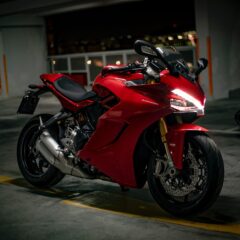
7 Top Motorcycle Accessories
With Christmas just around the corner, you might be wondering what to get your favourite motorcycle enthusiast or even a little something for yoursel...
 Phoenix Motorcycle Training LTD
Phoenix Motorcycle Training LTD
 Phoenix Motorcycle Training LTD
Phoenix Motorcycle Training LTD
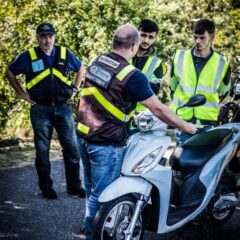
Have you ever watched a motorcyclist filter through traffic? Envied the graceful movements of a biker as they neatly navigated twisting turns with seeming ease? Or maybe you’ve sat on the back of a motorcycle and thought “I wish I was up front, riding”? All of these scenarios (and more) can ignite your desire to embark on your beginner motorcycle journey.
Beginnings can be daunting. Learning to ride a motorcycle is likely to be one of those exciting, scary and nerve wracking times. But it doesn’t have to be. Learning new skills is good for you. It expands your outlook on life, builds confidence, and helps you grow into a better version of you. Getting prepared for your beginner motorcycle journey makes it less intimidating. It’ll reduce any motorcycle anxiety you may have too.
This blog shares all you need to know about embarking on the road to two-wheeled mastery. It’s a long and exciting ride. One where you’ll never stop learning. And although it may be daunting to get started, one day you’ll look back on your beginner motorcycle days fondly. Trust us; we know because we’ve been there.
First up, it is natural and healthy to be a little scared of trying anything new. That’s your brain trying to protect you. But letting fear rule your life never did anyone any good. Instead, you need to listen to it, prepare well for what’s to come and move ahead with confidence anyway. It’s exactly the same with beginner motorcycle lessons.
Learning about what to expect as you learn to ride will build your confidence. It’s part of the mental preparation and will help you to overcome any motorcycle anxiety you may have about embarking on your beginner motorcycle journey. For most of us, learning to ride a motorbike begins with compulsory basic training and getting your CBT certificate. You can also opt for a Try Ride, to see if this motorcycle lark is really for you.
Fear of coming off your bike, crashing into another vehicle, wildlife, pedestrians or anything else is totally valid. That’s why compulsory basic training for your first motorcycle licence covers the theory and practice of safe riding. It includes…
You’ll practice these techniques and routines in a safe, private tarmaced area before going anywhere near a public road. Any approved training body (ATB) for motorcycle training has to meet strict DVSA standards for getting you prepared to ride safely and confidently in the UK. Knowing this will help you overcome any fear of riding.
So you’ve taken a Try Ride and you know that you’ll never shake the motorcycling bug. It’s time to get on the path to a UK motorcycle licence! This is the very first official step of your beginner motorcycle journey.
There are a few caveats and exceptions, but you’ll need a CBT certificate to ride a 125cc motorcycle or scooter if you’re 16 or older. Training covers all the basics of riding – just like the name suggests. You’ll gain the skills and confidence you need to carry on practicing and learning by yourself on public roads.
Once you get your CBT, you’ll need to show L plates front and back, avoid the motorway, and tell your friends to catch the bus. The CBT certificate isn’t technically a licence. You’ll need to carry a probationary licence or a driving licence with a photo or copy of your CBT to legally ride on public roads.
Your CBT is valid for two years, which should be long enough to grow your skill and move onto a full licence. If you’re happy with all of the conditions that come along with your CBT, you can recertify just before that two years is up. It’s totally your choice.
If you do decide to go for a full motorcycle licence, you have two options depending on your age. There is the progressive route to a full, unrestricted UK motorcycle licence. That involves moving up each licence level every two or so years. If you’re 16 when you get your CBT, this means getting your A1 licence after your 17th birthday, moving to the A2 licence when you’re 19 or older and finally reaching the pinnacle of all UK motorcycle licences, the full unrestricted A licence. You can train and test for the A licence once you’ve been riding with an A2 licence for two years or more.
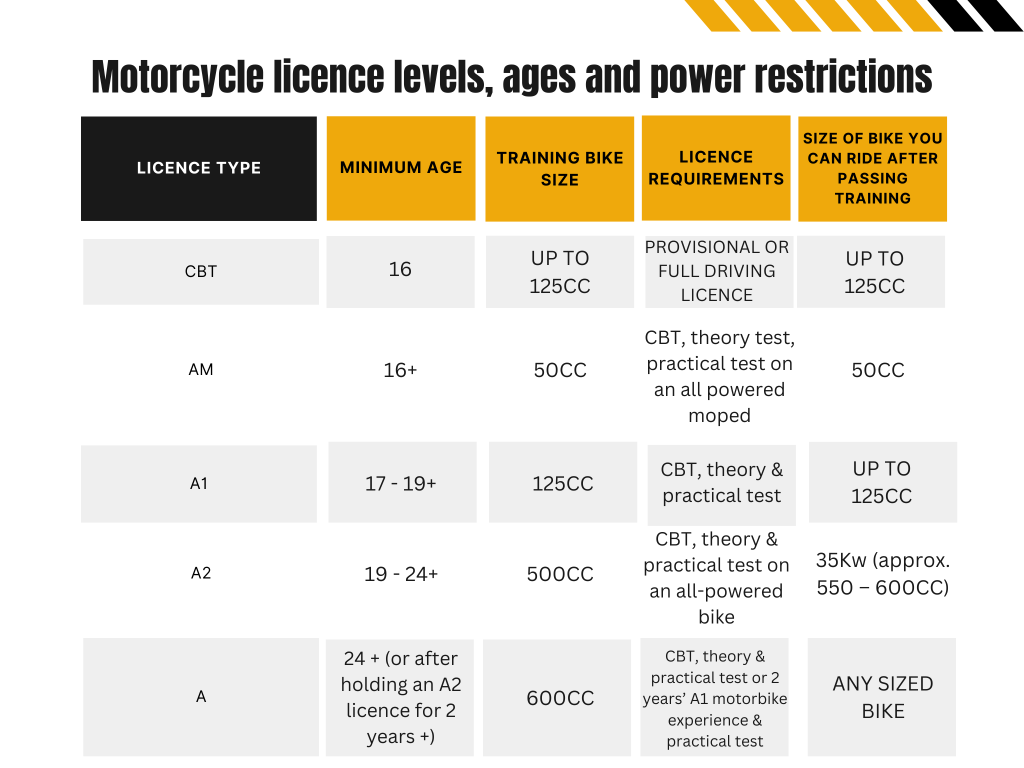
On the other hand, if you’re answering your motorcycling urge later in life you have the Direct Access Scheme (DAS) option. DAS training prepares you to test for the highest level licence for your age. If you’re 24 or older, that’s an A licence, the full unrestricted UK motorcycle licence. If you’d like a little more training before this, the CBT Plus course is worth taking a look into. This builds on the skills you learned on your CBT.
UK motorcycle licences come with age and power restrictions. For those at the start of their beginner motorcycle journey, the CBT certificate is the first step. This certificate allows you to ride a motorcycle or scooter up to 125ccs.
Depending on your next step – DAS or the progressive licensing route – you may then move to a 500cc motorcycle or a larger motorbike. These power restrictions are going to be your first consideration when you go motorbike shopping. But that shouldn’t be the only thing guiding your decisions.
Your budget, expected riding conditions and how you intend to use your motorbike are key factors to guide your choice. Some riders like a dual bike that can be used on and off road. There are plenty to choose from in this range. If you got your CBT to become a courier or fast food delivery person, a scooter or moped might be better.
Budget is also something to think about. As a general rule of thumb, smaller motorbikes are cheaper to run, cost less to buy, and cost less in maintenance too. If you’re never going to take your motorcycle on the motorway or off road, a smaller street motorbike is a reasonable choice. The lighter weight makes them easier to handle, which is perfect for heavy traffic conditions commuters may choose a motorcycle for.
There is no ‘best motorbike for beginners’. There are loads of great bikes to choose from while you’re starting out. One of them will be perfect for you. But what you want is probably different from the next person. In fact, we’re pretty sure that Teapot One’s wife has different ideas to him about motorbike shopping…
So, instead of convincing you of the best motorbike for your beginner motorcycle journey, let’s take a look at what you’ve got to choose from when you have your CBT in hand along with the things you should consider.
Honda’s CBF125 is a popular choice for beginner motorcyclists. It’s light so motorcycle manoeuvres are easier, comes with two different seat heights (775mm and 790mm), and is economical on fuel. You’ll be able to reach around 65mph without too much trouble. That makes it great for all the roads CBT holders can ride it on.
Whether or not you’re a Honda fan, when you go motorbike shopping, you’ll need to consider a few things before you head out. Your budget (of course) is important, the manoeuvrability of the motorcycle, the seat height and where you intend to use it will influence your decision. If you’re commuting and taking short rides, it’s perfect.
Same considerations as motorcycles though. Think about your budget, the seat height (you need to be able to get your foot comfortably flat on the ground while your butt is in the seat), and your intended use. Delivery people and couriers love mopeds for a reason – they’re fuel efficient and easy to manoeuvre.
The Kymco Agility 50 is a popular choice for beginner riders in the UK. It’s comfortable to ride, agile in traffic (as the name suggests), and fuel efficient too.
One of the key differences is the classic range you can choose from. Vespas, Lambrettas and Royal Alloy are a few of the makes that could be getting your motor running. But classic wheels aren’t cheap. If you’re dreaming of riding a scooter with your beginner motorcycle licence (AKA CBT certificate), consider your budget, where you’ll ride, and comfort while you’re riding too.
Uncomfortable motorbikes, mopeds and scooters aren’t safe for you or other road users.
But if money is no object, the classic ‘67 Super Sprint 90, Vespa is one of the most desirable in the world. It’ll set you back a cool £33,000 or more.
Just as important and your motorcycle is your beginner motorcycle kit. Obviously, helmets are a legal requirement. Jackets, gloves and boots are essential if you like your skin and bones where they are. A waterproof backpack is a good idea if you want to take anything with you when you ride in the UK.
All beginner motorcycle riders in the UK will learn about the controls of their machine with the Compulsory Basic Training (CBT) course. Understanding these and getting comfortable with them is the aim of parts B and C of your motorcycle training. The CBT course intentionally takes your training at a comfortable pace. That’s so you gain the essential skills you need to be safe on the road.
Planned motorcycle manoeuvres with smooth use of your clutch, throttle and brake are safest. You’ll practice this as you train for your CBT and should keep practicing this as you hone your skill and prepare for higher level licences.
Balance is key for motorcyclists. That’s one of the reasons we recommend all beginner motorcycle riders learn how to ride a bike if they don’t already know how to. The muscle memory used for cycling is easily transferred to motorcycling. It will make your CBT course go smoother and faster if you already have this skill. Not needing to concentrate on balance will help you become more coordinated with the controls and rider routines you’ll learn and use as you ride. These will also become second nature.
Mastering essential manoeuvres like turning smoothly, stopping slowly, emergency braking and changing gears takes a little time. Don’t be hard on yourself while you start out. It feels clunky and unfamiliar. Mostly because it is when you’re starting! Keep at it and you’ll remember the moment it all fits together smoothly with fondness.
A good motorcycle instructor will coach you and encourage you to keep going, giving tips and pointers to help you develop. Often it’s just after you think “I’m never going to get this!” that everything falls into place and you wonder why it seemed so difficult.
Have you ever heard the phrase “anything worth learning takes time”? This can’t be more true for learning to ride a motorcycle. It takes time. That’s why the UK’s motorcycle licensing process is designed the way it is.
You need to build skills steadily over time. You’re CBT certificate isn’t a ‘proper’ licence. It’s more like a learner permit that you can and should use to continue developing your motorcycle skills. The experience you get on the road as a new rider is invaluable. It will develop your hazard perception, understanding of your motorcycle, and turn your new found skills into muscle memory and automatic behaviours.
Practice and repetition are critical for you to develop these skills. Your CBT is valid for two years. We recommend you get out on your motorbike, moped or scooter at least once a week to continue developing your skills and confidence.
Your brain prioritises information and actions that you repeat. It notices that it’s important and commits more energy into embedding that knowledge and making it easier for you to access when you need it. So riding regularly is all about training your brain and your body to handle your motorcycle, moped or scooter better. It’s how you improve.
Safe practice areas, like empty car parks and open tarmacked areas without traffic are great for motorcycle practice. If you’ve had a close shave, want to focus on a particular routine or motorcycle manoeuvre, these spaces are perfect. You’ll be able to focus without the distraction of traffic. Try practicing figure of eight manoeuvres, emergency stopping, and counter steering in these settings. Going over these three motorcycle training exercises will help you develop into a better rider in less time.
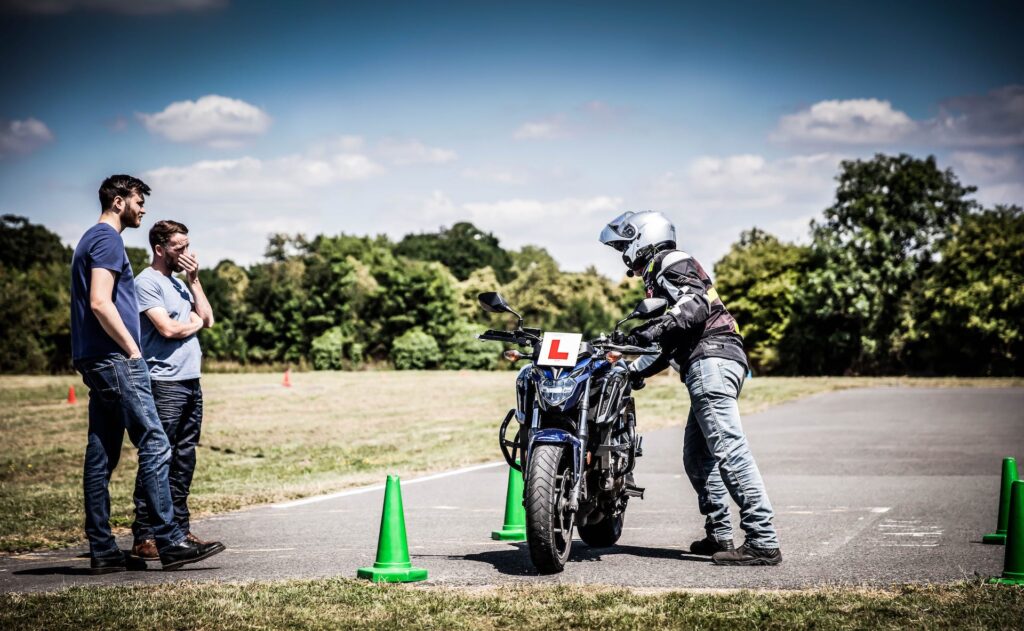
There is nothing to stop you from practicing advanced riding techniques as a beginner motorcyclist. The earlier you do, the faster you will develop your skills. Cornering, braking, and overtaking are good skills to start developing early on. Even with your CBT and a lower powered motorbike, you can grow your skills. And you should. Here’s how…
The delight of taking corners with ease and grace is one of the things you’ll love about riding. It’s a good skill to focus on. Successful cornering is as much about your body’s position as it is about controlling your motorcycle.
To get into the right position for cornering, keep your upper body relaxed. Anchor your outside leg towards your fuel tank, firmly place the balls of your feet on the footpegs. Keep your arms horizontal and elbows loose. Adjust your speed and gear for the approaching turn. Tense your stomach and outside leg as you enter the turn and push the opposite handlebar to your tensed leg. This is called ‘counter steering’ and it works with the physics of motion, the shape of your motorcycle tyres and makes cornering easier. Follow this with a push to the side of the handlebar that corresponds to the direction of the curve.
It’s best to practice the full cornering motorcycle manoeuvres on familiar roads. These cornering exercises will help you turn new-found motorcycle cornering skills into healthy riding habits.
Your motorcycle, moped or scooter has excellent brakes. The front brake is the one you will use most often. Practicing using it will increase your comfort and safety on the road. Using front and back brakes simultaneously is an important skill to learn too.
Your rider position impacts your braking, so it’s important to be aware of how you are positioned on your bike. Anchor your feet on the pegs. Keep your knees and thighs hugging your fuel tank. Use your stomach and lower back muscles to hold your position towards the back of the bike. This feeds the inertia to the back wheel and stops it lifting. Your arms should be loose and relaxed.
Apply pressure smoothly and consistently. Don’t yank your brakes or be timid with them either. Find the middle ground for smoother, safer and efficient braking. Practice braking consciously with these three braking exercises. These will build your confidence and familiarity with your brakes and how they behave in different riding conditions.
You’ll need to master acceleration to pass slower traffic quickly, safely and smoothly. Too much or too little acceleration can be dangerous for you. Again, you’ll need to practice acceleration techniques to find the middle ground and know how much you need in different situations.
Timing, your rider position, and speed all play important parts in overtaking slower traffic safely. Plan overtaking before you begin your motorcycle manoeuvre. Move your body lower on the bike to prepare for the planned acceleration. You should lean forward, anchor your feet on the pegs and keep your arms and hands relaxed. Focus your gaze far ahead.
Choose a lower gear to increase your revs. Check the distance to the car ahead, your mirrors and blind spots, then indicate. Pull your bike out to the right, accelerate smoothly and consistently, pass the car at a safe distance and smoothly guide your motorcycle back to the left hand side of the road. Make sure to check mirrors, blindspots and indicate before you move back to your lane.
Weather conditions change the road surface, other driver’s behaviours and how your motorcycle behaves on the road. Other riding conditions such as unexpected gravel patches and spilt diesel can also cause concern. Handling difficult riding conditions well takes skill and confidence in the rider techniques you’re learning. Regardless of the weather or road conditions, you should always…
Preparing for wet, cold and dry, or hot weather is also important. These tips will help you navigate these weather conditions safely.
Learning to ride a motorcycle is a lot of fun. The best start for your beginner motorcycle journey is to get in touch with an experienced and respected motorcycle training school. Look for one with knowledgeable and friendly instructors. All of Phoenix Motorcycle Training instructors are DVSA qualified along with Level 3 Award in Education and Training certification. That means they’ve learned how to adapt their teaching style to suit different learners.
Our beginner motorcycle training courses include…
Check out TrustPilot to find out what you can expect when you train with us. We also recommend you do this for any other approved training body you might choose for motorcycle licensing. To further your skills and grow your confidence, we also offer a CBT Plus course. This one to one coaching helps embed the knowledge you gained on your CBT and develop your skills further.
Online learning platforms, motorcycle communities and YouTube clips are another great way you can keep learning and become a better rider. Aside from our own YouTube channel, we’re quite partial to Teapot One’s YouTube clips. But there are plenty of different channels offering sound and free advice to new and experienced motorcycle riders. The key to getting better at motorcycle riding is to stay curious and willing to learn.
Motorcycle clubs and communities are another great way to keep practicing and meet other people interested in riding. You’ll learn from their stories almost as much as you will from regularly riding with these groups. Continual learning is a must when you ride a motorcycle. Even our motorcycle training instructors keep developing their skills through conscious riding, reading, and gaining certifications for teaching advanced rider courses if they want to. Riding a motorcycle is a calling you’ll never regret answering. Start your beginner motorcycle journey with us today!

With Christmas just around the corner, you might be wondering what to get your favourite motorcycle enthusiast or even a little something for yoursel...
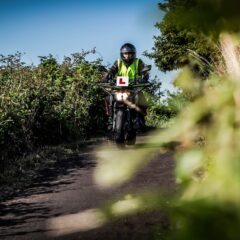
If you love motorcycle riding, you’ve probably daydreamed about riding a motorbike for a living. A professional racer or stunt rider is OK for some...
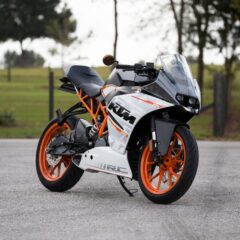
Getting a UK motorcycle licence can seem a complicated process. Particularly when compared to a driving licence for a car. Whether you choose the pro...
This website uses cookies to personalise content, ads, and analyse traffic, sharing data with partners who may combine it with other information. See our Privacy Policy for more information.